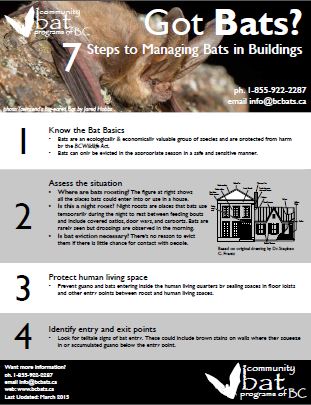 Bats provide benefits to both people and ecosystems, but not everyone is keen on sharing their living space with them. The BC Community Bat Project has produced a guide to managing bats in buildings, using techniques that protect both the bats and human inhabitants. The two-page brochure brochure (pdf) provides information for people with homes or buildings that have become roost sites for bats. It provides guidelines for safely evicting bats when desired, or protecting living space in cases where owners are amenable to allowing the bats to stay put (if there’s little chance of contact with humans). The organization has also produces a more detailed guide aimed at BC pest management professionals, or those looking for more detailed information. Both documents were produced with the financial support of Habitat Conservation Trust Foundation, Government of Canada, and Columbia Basin Trust.
Bats provide benefits to both people and ecosystems, but not everyone is keen on sharing their living space with them. The BC Community Bat Project has produced a guide to managing bats in buildings, using techniques that protect both the bats and human inhabitants. The two-page brochure brochure (pdf) provides information for people with homes or buildings that have become roost sites for bats. It provides guidelines for safely evicting bats when desired, or protecting living space in cases where owners are amenable to allowing the bats to stay put (if there’s little chance of contact with humans). The organization has also produces a more detailed guide aimed at BC pest management professionals, or those looking for more detailed information. Both documents were produced with the financial support of Habitat Conservation Trust Foundation, Government of Canada, and Columbia Basin Trust.
For more information on managing bats in building, email info@bcbats.ca
Beneficial Bats
- Bats consume large amounts of insects: in a lab test, a single little brown bat consumed over 600 mosquitos in one hour! Bats also feast on insect species that damage crops and trees, making them forestry and agricultural allies.
- Bat droppings, or guano, provide the primary nutrient source for cave ecosystems. It’s high in nitrogen, phosphorous, and potassium, all important nutrients for plant growth. The BC Community Bat project suggests using guano left behind from night roosts as an excellent free fertilizer!
- Though the bats in BC aren’t nectar-eaters, bats do play an important role as pollinators and seed dispersers in other parts of the world. In fact, Agave tequilana, the plant used to make tequila, is a chiropterophilous, or bat-pollinated, plant.





